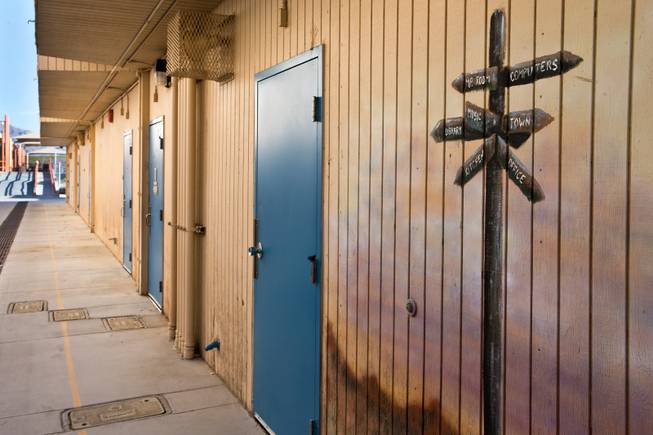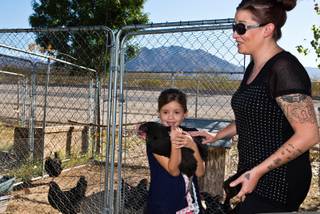
Portable classrooms at the Sandy Valley school sit mostly idle after flood damage three years ago. The campus, pictured here Thursday, Sept. 24, 2015, now features twice as many portable classrooms as permanent ones.
Tuesday, Sept. 29, 2015 | 2 a.m.
SANDY VALLEY — Shana Hairston can still remember sitting in class in the old building on the Sandy Valley School campus.
The spacious, windowless classrooms dating back to when the school was founded in 1984 aren’t anything to get excited about, but they have sentimental value, just like the sapling she and her classmates planted in the dirt outside in the mid-90s, now a towering pine after all these years.
But a bad storm years ago caused flash flooding that sent a river of mud washing through campus. Hairston’s old classroom building was inundated with more than a foot of sludge that soaked into the structure. Mold grew, followed by a dank, musty stench. Not wanting to risk the health of the 300 elementary, middle and high school students that share the small campus, Principal Chris Lounsbery ordered the classrooms condemned.
Now Hairston is 25 and has a daughter, Natasha, attending second grade at the school. The condemned classrooms are still vacant, but they stand as a lasting symbol of dissatisfaction for this rural desert community, where California is a literal stone’s throw away and the economy is a mix of ranching, farming and the mining of minerals like zeolite.
For years, people like Hairston and her mother, Dawn Haviland, have been pushing the Clark County School District to honor a plan to renovate the aging campus and build much-needed classroom space.
“The school district has had a habit of thinking of us as the red-headed stepchild,” Hairston said. “Enough of that. It’s time to give us the facilities that we need.”
The plan, which is awaiting final district approval, calls for construction in three phases. The first phase includes a new gym that will be completed by August 2016, finally replacing the school’s gigantic 9-year-old portable gym that towers over the rest of the campus. The basketball floor is made of plastic and is uneven.
“I tease that we’re always good for about two or three turnovers per game,” said Lounsbery.
The other two phases, which call for the construction of an additional eight high school classrooms as well as permanent facilities for the school’s elementary grades, are still uncertain.
This month, the school district held a series of hearings designed to gauge public opinion on how to spend $4 billion in newly approved bond money, its first major period of construction since 1998.
Hairston and Haviland drove 50 miles from Sandy Valley to Durango High School for a recent hearing, where a district administrator was giving a presentation on the school’s theater stage.
“This is a great stage. I’d love to see my daughter be able to perform on one like this one day. But we don’t have that,” Hairston said in a public comment period.
But at the same time that rural communities Sandy Valley, Moapa Valley and Virgin Valley are struggling with aging and inadequate facilities, urban neighborhoods in Las Vegas are struggling under the weight of overcrowding and the ever-present specter of population growth.
The district maintains that it could build 38 elementary schools and immediately fill them with students. On top of that, CCSD estimates that the revenue it will receive from the upcoming 10-year bond period will pay for only half of the district’s estimated need.
As a result, the district now finds itself having to juggle the construction of vital new schools with the long-standing demands of communities across the county.
“The big tradeoff is: How much money do we put toward new schools and how much money do we put toward modernizing our old schools?” district financial chief Jim McIntosh said. “We recognize that we have such a large rural population and we need to meet those populations.”
And it’s not just Sandy Valley. Residents of Mesquite and Laughlin have long clamored for new gyms at their schools, and the district only recently built a gym at Moapa Valley High.
But brand new gyms don’t satisfy the urgent need for renovation and expansion in some schools.
The infrastructure that serves Sandy Valley School is woefully outdated. The pumps that operate the school’s well date back to when it was first opened in 1984. They broke on the first day of school this year, leaving classrooms without running water in a valley where summer temperatures can reach up to 120 degrees.
Around 70 percent of students at Sandy Valley School are taught in portable classrooms, including the entire high school. Many of the portables that serve the elementary students are more than 20 years old and well past their lifespan. They are dirty and worn on the outside, and have a faint musty smell on the inside. The facilities lack the equipment to offer routine science classes like AP Biology or Chemistry.
The school operates on a septic system, but the leach fields used to treat the sewage are also past their lifespan. What’s worse, they are located directly underneath the elementary playground and baseball field.
“Just imagine what will happen when those start to go,” Hairston said. “And there’s kids playing on top of them.”
Far from the impressive theaters you’ll find in urban schools like Durango or Las Vegas Academy, the Sandy Valley School theater is just a tiny opening in the cafeteria. The curtains are simple black sheets strung over a thin rod resembling chicken wire.
“It’s no child left behind, right?” Hairston said. “It shouldn’t matter if the kid lives in the city or in a rural town.”
The school board of trustees recently added the Sandy Valley School to its list of construction priorities in the next 10 years, but it means Hairston, Haviland and the rest of the community may have to wait more than five years before ground is broken on new facilities.
They doubt it can wait that long.
“It’s not what you have, it’s what you do with what you have,” Lounsbery said. “But we need to finish this school.”


Join the Discussion:
Check this out for a full explanation of our conversion to the LiveFyre commenting system and instructions on how to sign up for an account.
Full comments policy